Shoulder Care
The orthopedic surgeons at Great Lakes Orthopedics & Sports
Medicine, P. C. can evaluate your shoulder condition and provide the customized treatment plan to get you back to enjoying life!!
Shoulder Bursitis
Shoulder Specialists In The Greater St. John, Crown Point and Lowell, Areas
The orthopedic surgeons at Great Lakes Orthopedics & Sports Medicine, P. C. treat shoulder conditions and injuries at their 3 convenient offices in
St. John, Crown Point and Lowell, Indiana. Our orthopedic physicians are specially-trained in treating shoulder conditions and injuries. As leaders in orthopedic care, we provide minimally invasive and innovative treatment options, as well as utilizing state-of-the art technologies, to create unique and individualized care plan designed to get you back on your road to recovery and regaining an active lifestyle!!
FAQs on Shoulder Bursitis
Shoulder Bursitis
Shoulder bursitis is a condition of the shoulder joint. The rotator cuff is a group of four muscles and their tendons that wrap around to form a “cuff” over the upper end of the arm at the shoulder. The rotator cuff helps guide the shoulder through many motions by allowing lift and rotation to the arm while stabilizing the ball of the shoulder within the socket. The space over the top of the rotator cuff is occupied by a bursa which is a fluid sac between the tendon and the acromion bone.
Bursitis, a common condition, is inflammation of this fluid sac and occurs with repetitive overhead activity or overuse of the arm. The term impingement refers to pinching of the rotator cuff tendons and bursa against the acromion bone above it.
Cause & Symptoms
Cause
Your shoulder is made up of three bones: your upper arm bone (humerus), your shoulder blade (scapula), and your collarbone (clavicle).
Your arm is kept in your shoulder socket by your rotator cuff. These muscles and tendons form a covering around the head of your upper arm bone and attach it to your shoulder blade.
There is a lubricating sac called a bursa between the rotator cuff and the bone on top of your shoulder (acromion). The bursa allows the rotator cuff tendons to glide freely when you move your arm.
The rotator cuff is a common source of pain in the shoulder. Pain can be the result of Bursitis. The bursa can become inflamed and swell with more fluid causing pain.
Symptoms
Rotator cuff pain commonly causes local swelling and tenderness in the front of the shoulder. You may have pain and stiffness when you lift your arm. There may also be pain when the arm is lowered from an elevated position.
Beginning symptoms may be mild. Patients frequently do not seek treatment at an early stage. These symptoms may include:
- Minor pain that is present both with activity and at rest
- Pain radiating from the front of the shoulder to the side of the arm
- Sudden pain with lifting and reaching movements
- Athletes in overhead sports may have pain when throwing or serving a tennis ball
As the problem progresses, the symptoms increase:
- Pain at night
- Loss of strength and motion
- Difficulty doing activities that place the arm behind the back, such as buttoning or zippering
- If the pain comes on suddenly, the shoulder may be severely tender.
All movement may be limited and painful.
Diagnosis
Medical History and Physical Examination
Your Great Lakes Orthopedics & Sports Medicine orthopedic surgeon will test your range of motion by having you move your arm in different directions.
After discussing your symptoms and medical history, your doctor will examine your shoulder. He or she will check to see whether it is tender in any area or whether there is a deformity.
To measure the range of motion of your shoulder, your doctor will have you move your arm in several different directions. He or she will also test your arm strength.
Your doctor will check for other problems with your shoulder joint. He or she may also examine your neck to make sure that the pain is not coming from a “pinched nerve,” and to rule out other conditions, such as arthritis.
Imaging Tests
Other tests which may help your doctor confirm your diagnosis include:
X-rays. Becauses x-rays do not show the soft tissues of your shoulder like the rotator cuff, plain x-rays of a shoulder with rotator cuff pain are usually normal or may show a small bone spur. A special x-ray view, called an “outlet view,” sometimes will show a small bone spur on the front edge of the acromion.
Magnetic Resonance Imaging (MRI) and Ultrasound. These studies can create better images of soft tissues like the rotator cuff tendons. They can show fluid or inflammation in the bursa and rotator cuff. In some cases, partial tearing of the rotator cuff will be seen.
Treatment Options
Nonsurgical Treatment
In most cases, initial treatment is nonsurgical. Although nonsurgical treatment may take several weeks to months, many patients experience a gradual improvement and return to function.
- Rest. Your doctor may suggest rest and activity modification, such as avoiding overhead activities.
- Non-steroidal Anti-Inflammatory Medicines. Drugs like ibuprofen and naproxen reduce pain and swelling.
- Physical Therapy. A physical therapist will initially focus on restoring normal motion to your shoulder. Stretching exercises to improve range of motion are very helpful. If you have difficulty reaching behind your back, you may have developed tightness of the posterior capsule of the shoulder (capsule refers to the inner lining of the shoulder and posterior refers to the back of the shoulder). Specific stretching of the posterior capsule can be very effective in relieving pain in the shoulder. Once your pain is improving, your therapist can start you on a strengthening program for the rotator cuff muscles.
- Steroid Injection. If rest, medications, and physical therapy do not relieve your pain, an injection of a local anesthetic and a cortisone preparation may be helpful. Cortisone is a very effective anti-inflammatory medicine. Injecting it into the bursa beneath the acromion can relieve pain.
Surgical Treatment
When nonsurgical treatment does not relieve pain, your doctor may recommend surgery.
The goal of surgery is to create more space for the rotator cuff. To do this, your doctor will remove the inflamed portion of the bursa. He or she may also perform an anterior acromioplasty, in which part of the acromion is removed. This is also known as a subacromial decompression. These procedures can be performed using either an arthroscopic or open technique.
Arthroscopic Technique
In arthroscopy, thin surgical instruments are inserted into two or three small puncture wounds around your shoulder. Your doctor examines your shoulder through a fiberoptic scope connected to a television camera. He or she guides the small instruments using a video monitor, and removes bone and soft tissue. In most cases, the front edge of the acromion is removed along with some of the bursal tissue.
Your surgeon may also treat other conditions present in the shoulder at the time of surgery.
These can include arthritis between the clavicle (collarbone) and the acromion (acromioclavicular arthritis), inflammation of the biceps tendon (biceps tendonitis), or a partial rotator cuff tear.
Open Surgical Technique
In open surgery, your GLO surgeon doctor will make a small incision in the front of your shoulder. This allows your doctor to see the acromion and rotator cuff directly.












